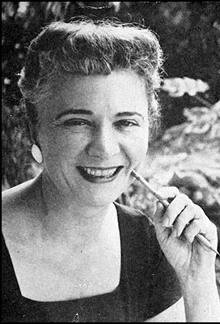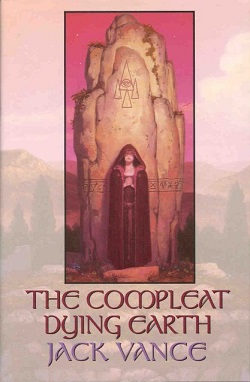
Catherine Lucille Moore was an American science fiction and fantasy writer, who first came to prominence in the 1930s writing as C. L. Moore. She was among the first women to write in the science fiction and fantasy genres. Moore's work paved the way for many other female speculative fiction writers.

Dying Earth is a speculative fiction series by the American author Jack Vance, comprising four books originally published from 1950 to 1984. Some have been called picaresque. They vary from short story collections to a fix-up, perhaps all the way to novel.

Poul William Anderson was an American fantasy and science fiction author who was active from the 1940s until his death in 2001. Anderson also wrote historical novels. He won the Hugo Award seven times and the Nebula Award three times, and was nominated many more times for awards.

Kathy Diane Wentworth, known as K. D. Wentworth, was an American science fiction author. A University of Tulsa graduate, she got her start winning the Writers of the Future Contest in 1988, and then later won Field Publications' "Teachers as Writers" Award in 1991. Wentworth served two terms as secretary of the Science Fiction and Fantasy Writers of America in the early 2000s. She served as the editor for the Writers of the Future Contest from 2009 until her death. One of her novelettes, "Kaleidoscope" (2008), and three of her short stories, "Burning Bright" (1997). "Tall One" (1998), and "Born Again" (2005) have been Nebula Award finalists. Wentworth died on April 18, 2012, from complications with pneumonia and cervical cancer.

Gardner Raymond Dozois was an American science fiction author and editor. He was the founding editor of The Year's Best Science Fiction anthologies (1984–2018) and was editor of Asimov's Science Fiction magazine (1986–2004), garnering multiple Hugo and Locus Awards for those works almost every year. He also won the Nebula Award for Best Short Story twice. He was inducted to the Science Fiction Hall of Fame on June 25, 2011.

Joe William Haldeman is an American science fiction author.
The Internet Speculative Fiction Database (ISFDB) is a database of bibliographic information on genres considered speculative fiction, including science fiction and related genres such as fantasy, alternate history, and horror fiction. The ISFDB is a volunteer effort, with the database being open for moderated editing and user contributions, and a wiki that allows the database editors to coordinate with each other. As of April 2022, the site had catalogued 2,002,324 story titles from 232,816 authors.

The Magazine of Fantasy & Science Fiction is a U.S. fantasy and science-fiction magazine, first published in 1949 by Mystery House, a subsidiary of Lawrence Spivak's Mercury Press. Editors Anthony Boucher and J. Francis McComas had approached Spivak in the mid-1940s about creating a fantasy companion to Spivak's existing mystery title, Ellery Queen's Mystery Magazine. The first issue was titled The Magazine of Fantasy, but the decision was quickly made to include science fiction as well as fantasy, and the title was changed correspondingly with the second issue. F&SF was quite different in presentation from the existing science-fiction magazines of the day, most of which were in pulp format: it had no interior illustrations, no letter column, and text in a single-column format, which in the opinion of science-fiction historian Mike Ashley "set F&SF apart, giving it the air and authority of a superior magazine".
Edward Lewis Ferman is an American science fiction and fantasy editor and magazine publisher, known best as the editor of The Magazine of Fantasy and Science Fiction (F&SF).

John Brian Francis "Jack" Gaughan, pronounced like 'gone', was an American science fiction artist and illustrator and multiple winner of the Hugo Award in the category of Best Professional Artist.
Betty Ballantine was an American publisher, editor, and writer. She was born during the Raj to a British colonial family. After her marriage to Ian Ballantine in 1939, she moved to New York where they created Bantam Books in 1945 and established Ballantine Books in 1952. They became freelance publishers in the 1970s. Their son, Richard, was an author and journalist specializing in cycling topics.
Howard Vincent Hendrix is an American scholar and science fiction writer.. He is the author of the novels Lightpaths and Standing Wave, Better Angels, Empty Cities of the Full Moon, The Labyrinth Key, and Spears of God. His early short stories are found in the ebook Mobius Highway.

Richard C Bowes was an American author of science fiction and fantasy.
Charles Coleman Finlay is an American science fiction and fantasy author and editor.
Michael Shayne Bell is an American science fiction writer, editor, and poet. He won the second quarter of the 1986 Writers of the Future contest with his story, "Jacob's Ladder". His short works have been nominated for the Hugo and the Nebula Awards. The Association for Mormon Letters awarded him for editorial excellence with his Washed by a Wave of Wind: Science Fiction from the Corridor anthology in 1994. Baen Books published Nicoji, a novel based on his short story of the same name, in 1991.
Carlton Frederick, better known as Carl Frederick, is an American science fiction author and physicist. His nonfiction book est: Playing the Game the New Way describing the Erhard Seminars Training (est) theatrical experience. reached number 2 on the New York Times bestseller list.

In Search of Wonder: Essays on Modern Science Fiction is a collection of critical essays by American writer Damon Knight. Most of the material in the original version of the book was originally published between 1952 and 1955 in various science fiction magazines including Infinity Science Fiction, Original SF Stories, and Future SF. The essays were highly influential, and contributed to Knight's stature as the foremost critic of science fiction of his generation. The book also constitutes an informal record of the "Boom Years" of science fiction from 1950 to 1955.
Mary Soon Lee is an American speculative fiction writer and poet.

FIYAH Magazine of Black Speculative Fiction, or simply FIYAH, is an American-based quarterly electronic magazine of Black speculative fiction. The magazine was announced in September 2016, inspired by the 1920s experimental periodical FIRE! created by Wallace Thurman. It was developed by a group of writers led by Troy L. Wiggins, L.D. Lewis, and Justina Ireland. The first edition of the magazine was published in 2017. FIYAH has been nominated for the Best Semi-Prozine Hugo Award five times, most recently in 2023, and it won the Hugo Award for Best Semi-Prozine in 2021.










